admin
Trudeau Adds to Laguiole Line
By Lorrie Baumann
Trudeau is updating the Laguiole collection of knives introduced at last year’s International Home + Housewares Show with new additions to the line that will allow home cooks to create a coherent cutlery story in their kitchens and dining rooms.
The Laguiole knives are Trudeau’s homage to the cutlers from a French village where Casimir-Antoine Moulin started making cutlery in 1829. The tradition flourished in France until it died out in World War I. It was revived locally in 1987. The Trudeau cutlery borrows signature elements of the Laguiole tradition, including the distinctively shaped handles embellished with a stamped bee design, for knives that are made in China and finished and assembled by hand.
Pocket knives were an important part of the Laguiole tradition, and early Laguiole pocket knives with handles made from Aubrac cow horn or bone were used by the local farmers and shepherds. The Trudeau knives bow to that tradition this year with a pair of pocket knives that include corkscrews. The Laguiole Deluxe XL corkscrew is made of stainless steel and pakka wood and comes packaged in a gift box, as do all of the Trudeau Laguiole knives. The Laguiole Waiter’s corkscrew is made of stainless steel and red stablewood and even comes with a leather case. The corkscrews are grooved to reduce friction for easier cork extraction.
Trudeau introduced the Laguiole steak knives last year. This year, there’s a choice of three handles: black horn, rosewood or pakka wood on knives hat feature thick gauge full-tang stainless steel serrated blades with hand stamped detailing on the handles, including the Laguiole bee. They retail for $99.99 for a set of six knives packaged in gift boxes.
Carving sets come with the same three handle choices. The three piece sets include a 6.25-inch carving fork, 7-inch carving knife and 7.25-inch knife sharpener. These sets also retail for $99.99 and are packaged in gift boxes.
New this year, Laguiole-style prep knife sets include a 7-inch Santoku knife, 5-inch utility knife and 3-inch paring knife with each of the three handle materials. The prep knife sets retail for $99.99 and also come packaged in gift boxes.
Finally, Trudeau is offering a new set of Laguiole cheese knives for soft cheeses. With thick gauge, full tang stainless steel blades and hand-stamped detailing on the handles, these knives function as both knives and spreaders. They are currently available only with pakka wood handles. A gift-boxed set of four retails for $39.99.
This story was originally published in the March 2015 issue of Kitchenware News, a publication of Oser Communications Group.
Store Compost Without Attracting Fruit Flies
CompoKeeper started as an answer to a smelly problem created when Boulder, Colorado adopted a municipal composting program. The municipal composting program was a well-intentioned effort to reduce waste going to the local landfills, which are expensive to build and maintain so that they don’t contaminate local groundwater, but like so many well-intentioned efforts, there were unintentional consequences.
The city handed out gallon-size plastic pails in which to collect organic waste in the kitchen. From there, the food scraps were to be taken to a curbside bin, where it was collected along with yard waste, recyclables and ordinary trash. The food scraps and yard waste went to a composting facility where it was turned into soil and distributed to local gardeners and various environmental rehabilitation projects. “My family was excited about it,” says Kristen Hess, Brand Manager and Co-founder of CompoKeeper. “What we found was that it was getting stinky in the kitchen, and also fruit flies were becoming a pain in the neck.”
The smell, the flies and the frequent trips outside to empty the small pail into the collection bin became obstacles that outweighed all the good intentions. “It wasn’t long before we stopped doing it – we stopped composting our food scraps,” Hess says.
Her dad, Van Hess, decided to do something about the situation, so he went to work on a bin system that would solve all the problems at once. It would be bigger than the small pail issued by the city. There would be no smell, and it wouldn’t breed fruit flies. “He found that he wanted the compostable bag to stay sealed when it wasn’t in use, but he didn’t want to use his hands to tie it and untie it, so he built clamps into the bin that are opened and closed with a foot pedal. Since the bag is sealed, odors are contained, and fruit flies are no longer an issue,” Hess says.
A Kickstarter campaign to raise funds to go into production didn’t raise enough pledges to give the Hesses their seed money, but it got noticed and people became interested enough to help the Hesses raise enough money to build a prototype. They also offered their ideas for improving the product, Hess said. “We made it better looking, added a bag tray to make it easier to extract the bag, added a charcoal filter,” Hess says. A local pitch slam in which entrepreneurs offered investment proposals to potential funders attracted an investor who put up enough cash to buy the necessary tools.
CompoKeeper went onto the market in September 2014, and it has continued to draw interest as more people have the opportunity to participate in municipal composting projects. CompoKeeper is currently available for $99.50 on the company’s website, and Sam’s Club has picked it up for a test run. The product is also available locally in Boulder and will be available online on Bed Bath & Beyond’s website this spring. The company is making its second appearance at the International Home + Housewares Show this year, and CompoKeeper is made in the USA. For further information, visit www.compokeeper.com.
This story was originally published in the March 2015 issue of Kitchenware News, a publication of Oser Communications Group.
How To Sell To The Time-Stressed, Time-Starved Customer
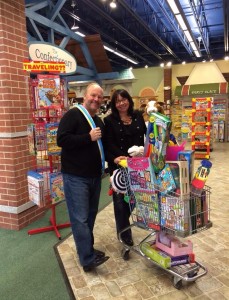 When a customer is shopping while stressed for time it is up to the retailer to be able to optimize the time they spend in the store, no matter how brief it may be. They might have just popped in on their way home from work and need to get in, pick up a tool to make dinner, and get out. If that customer walks out of the store feeling like they have met their goal, they will feel satisfied about their experience and walk away with a good impression of the business even if they were only in the store for seven minutes. To achieve this, retailers must have a layout that is well merchandised to the footprint of the store and have sales staff make contact with the customer immediately.
When a customer is shopping while stressed for time it is up to the retailer to be able to optimize the time they spend in the store, no matter how brief it may be. They might have just popped in on their way home from work and need to get in, pick up a tool to make dinner, and get out. If that customer walks out of the store feeling like they have met their goal, they will feel satisfied about their experience and walk away with a good impression of the business even if they were only in the store for seven minutes. To achieve this, retailers must have a layout that is well merchandised to the footprint of the store and have sales staff make contact with the customer immediately.
Rich Kizer and Georganne Bender, of Kizer & Bender Speaking, are self-proclaimed consumer anthropologists. They are professional speakers who specialize in retail strategies and consumer research. Their presentations to retailers at trade shows, markets, associations, and private events reflect 25 years of experience and research they have conducted through focus groups, one-on-one customer interviews, and field work that involves observing customers on the sales floor as they shop, collecting pre- and post-shopping impressions, clocking shopping times and more. They also work primarily with independent retailers directly in their stores and do sales training with store associates.
“We look for the very best, and sometimes the very worst, and try to share those experiences with people so they don’t make the same mistakes; they can take advantage of those success strategies,” says Kizer.
Kizer & Bender point to the store layout as the starting point for accommodating time-starved customers. The store must be well organized so that a shopper can easily navigate, find what it is they’re looking for and get out. Think about the layout logically, so that every fixture and display is put in a specific space for an identifiable reason, not simply because there was an open space.
For example, the first five to 15 feet inside the store, depending on the size of the sales floor, is the “Decompression Zone,” where customers are unlikely to notice merchandise, no matter how great it may be. Once a customer has moved past that decompression zone, they begin to fully take in the store. They only begin to do that once they are at least five feet inside the front door and have adjusted to the new environment. That’s when they start to notice products. Avoid placing key merchandise too close to your front entrance.
Next, 90 percent of people will walk in and first look or turn to the right. “That area has to be impeccably merchandised to get people thinking about products and categories, and garnering not just one item, but more than one,” says Bender.
With a well-merchandised layout, a good salesperson is able to easily guide a customer towards what they are looking for, while giving that salesperson the opportunity to weave a story along the way. It makes the store a bit more of a treasure hunt to the customer without a big effort.
Another aspect of the story created for customers within the store involves signage. Story Teller signs tell a customer why they should buy something. Story Tellers might read, “Imagine being able to juice whole oranges in five seconds flat!” Product Seller signs are those that provide vital information on product specifications and include a price point. For a customer who is burning time, signs are a representation of the store that can help them make speedy decisions. After all, 70 percent of purchasing decisions are made in the store, says Bender.
The other part of the equation for the time-stressed customer is the interactions they have with retail associates. Customers must be greeted immediately with a quality greeting, not just a simple “May I help you?” Kizer & Bender suggest thinking about how you would welcome a friend who arrived to your home, keeping in mind that the customer relationship starts as soon as they walk in the door. In conducting exit interviews with customers after following them through the store with a stopwatch, Kizer & Bender will ask how long it took for them to be greeted. If the store is not good at greeting people, the perceived time will always be greater than the actual time. They might respond that it took 10 minutes to be greeted when in reality it was only four.
“Even with the person that’s on a mission, say something other than ‘May I help you?’ That will minimize the perception inside that person’s head,” says Kizer. “A person who wants to come in and run out quickly can have an incredible experience in their mind after they leave. It was really only a transaction, but they turned it into a great experience because of the way it was handled.”
It can also be helpful to visually assess a customer by their body language upon entering the business. A shopper who is walking at a fast pace and quickly looking back and forth is sending signals that they are in a hurry. Be sure to offer help to this customer, but don’t get stuck on thinking that they are only going to be in and out – your interpretation might be wrong, or the customer might change their mind about how much time they have once they’ve received some contact and feel more at ease.
Beyond the initial greeting, staff must keep in mind at all times that the customer is the most important asset in the store. A sales associates might go back to whatever task they were doing once a customer says they do not need help, but they must keep an eye on that customer in case they decide they do have some questions.
“At some point in time you determine that you need help, you’ve been in the store for a while and nobody’s approached you, or made eye contact, or said anything to you. That’s when people become stressed out and they start to think negative things about your store,” says Bender. “It’s one of those things that people turn on in a second, but we hear it over and over and over again in focus groups.”
It is especially important in the realm of kitchenwares to give customers guidance so they know and understand what their options are. Retailers and salespersons are the experts that need to impart knowledge to their customers.
“When you walk in a store you know that you want to buy a particular item, but there are 14 different ways that you can use them, so which one is right for you? That’s the key. A good salesperson can weave a story around it and say, ‘Let me show you how it works.’ … This just gives the customer confidence and, unfortunately, that’s what customers don’t get enough of when they walk into stores,” says Kizer.
It all boils down to the customer walking away feeling satisfied about their experience, no matter how much time they spend in the store. “If a customer walks in and they’re really in a hurry, they’re time starved, stressed out, thinking, ‘I need this and I need to get out of here fast,’ and they are able to do that – they’re thrilled to death. The next time they think about your store, they’re thinking about it in a positive way because they had a good experience,” says Kizer.
This story was originally published in the March 2015 issue of Kitchenware News, a publication of Oser Communications Group.
Pin Peeler: Functional and Futuristic Vegetable Peeler
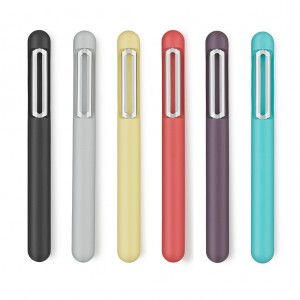 Simplicity and functionality are the main characteristics of the latest addition to Normann Copenhagen’s range of kitchen utensils. The Pin Peeler is pen-like in shape and has been stripped of any unnecessary details. Pin has a silicone covering to ensure a good grip, making the peeler fit comfortably in the hand.
Simplicity and functionality are the main characteristics of the latest addition to Normann Copenhagen’s range of kitchen utensils. The Pin Peeler is pen-like in shape and has been stripped of any unnecessary details. Pin has a silicone covering to ensure a good grip, making the peeler fit comfortably in the hand.
According to the designer Jan Christian Delfs, the pleasure derived from preparing food starts with having great kitchen utensils. A good kitchen utensil must be fun to work with and capable of mastering its function to perfection. With Pin, the designer has created a new interpretation of the classic vegetable peeler with a consistently minimalistic shape. The goal has been to create a design that enhances the pleasure of preparing food, both practically and visually.
The matte material and rounded edges soften the rigid feel and give the peeler an inviting appearance. Pin has a sharp, self-adjusting stainless steel blade, which rotates when in use. This also ensures that the peeler is comfortable and easy to work with, regardless whether you are left or right handed.
Pin is available in classic black and light gray as well as in four fresh colors; yellow, red, purple and turquoise. The vivid colors make it easy to find Pin amongst the other jumble in the kitchen drawer.
Suggested retail price for the Pin Peeler is $17.50. For more information visit www.Normann-Copenhagen.com.
More Tools & Gadgets here
Gray Goose Cookery: Kitchen Store With a Mission
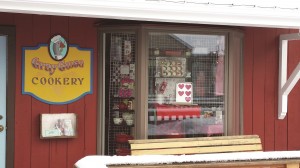 Suzanne Lane has come full circle with her weight loss journey and kitchenware store. It was the store she turned to for tools when she first began the journey to lose the 118 pounds she has lost so far. Now the journey is a main focus of the store, and she’s not done yet. At the Gray Goose Cookery in Mystic, Connecticut, Lane is not only the proprietor, she is the leading the charge for a healthy lifestyle in her community by encouraging others to learn about her journey and do the same with some help from herself and her kitchenware store.
Suzanne Lane has come full circle with her weight loss journey and kitchenware store. It was the store she turned to for tools when she first began the journey to lose the 118 pounds she has lost so far. Now the journey is a main focus of the store, and she’s not done yet. At the Gray Goose Cookery in Mystic, Connecticut, Lane is not only the proprietor, she is the leading the charge for a healthy lifestyle in her community by encouraging others to learn about her journey and do the same with some help from herself and her kitchenware store.
“Here I am in the food industry, and we always talk about food. It’s so easy to end up eating more than you should, and I put on a lot of weight over the years,” says Lane. “I decided to turn to my kitchen store and use the tools in my kitchen store to lose weight. I researched all the diets, and I created my own diet, and I did it. I followed my own diet, and I lost all this weight.”
From there, Lane had people approaching her and asking how she had done it. She followed the logical steps and decided to offer classes in her store to share her healthy-eating tips with others and The Pinch Diet was born. The premise is basic: healthy eating, exercise and just a pinch of temptation foods here and there to satisfy cravings while not giving in to them entirely.
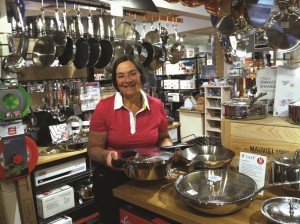 Coming from a culinary background, Lane has knowledge of food and food preparation that she is able to share with others who might be less inclined to find the joy in a salad on their own. A family of “foodies,” as she calls it, her mother and grandfather were both avid home cooks, and Lane herself managed several restaurants for two years in between her undergraduate and graduate degrees, even becoming chef within just six months.
Coming from a culinary background, Lane has knowledge of food and food preparation that she is able to share with others who might be less inclined to find the joy in a salad on their own. A family of “foodies,” as she calls it, her mother and grandfather were both avid home cooks, and Lane herself managed several restaurants for two years in between her undergraduate and graduate degrees, even becoming chef within just six months.
She eventually opened a gift store but had customers asking her to get kitchen tools for them, so a kitchenware store seemed a natural transition. She had designed a logo for her retired mother to use for a catering company that was to be called Gray Goose Catering. When that fell through and Lane was ready to open up for business, she decided to use the logo she had already personally designed, and Gray Goose Cookery was born in 1995.
The shop is 4,000 square feet located in Olde Mistick Village, a shopping district built to recall New England’s colonial era. With the Mystic Aquarium just down the road and the Mystic Seaport about a half mile away, the store sees lots of tourists coming through during the summer months and enjoys local business throughout the year.
Lane also has a gift store, Elizabeth & Harriet, and a tabletop store, Gray Goose, Too, both located in Olde Mistick Village as well. She opened up Gray Goose, Too in 2005 after finding she had run out of room at Gray Goose Cookery. She also realized that tabletop items need a different sort of display than do kitchenwares and that they attracted a different sort of customer — one who tends to set the table rather than cook the food. In Mystic, the leisure set is big, given that the Mystic River is just right there, and folks need those entertaining pieces for their boats, poolside and al fresco dining. Gray Goose, Too is an entirely separate shop of 2,500 square feet located across the way from Gray Goose Cookery.
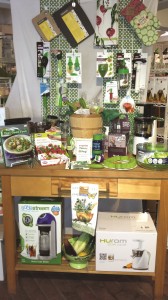 The product selection at Gray Goose Cookery is a reflection of what Mystic customers want. A combination of Baby Boomers and Millennials who are gadget-oriented with an eye on ease of use has lent itself well to the purpose of showcasing healthy eating tactics within the store.
The product selection at Gray Goose Cookery is a reflection of what Mystic customers want. A combination of Baby Boomers and Millennials who are gadget-oriented with an eye on ease of use has lent itself well to the purpose of showcasing healthy eating tactics within the store.
“Boomers and Millennials are really driving the marketplace, and that’s how we got somewhat into the healthy eating component,” says Lane. “The Millennials are coming in because we’re talking the language that they’re concerned about. They don’t want to eat all this processed food; they want to get back to the basics also.”
Whether it’s in her Pinch Diet classes or simply helping a customer in the store, Lane never misses an opportunity to share a healthy eating tidbit. If a customer is selecting an ice cream scoop, she will point out that the tool can also be used as a portion control scoop.
“Over the course of time I’ve shared what I’ve learned with my staff, and my staff has shared what I’ve passed on to them with the customers to educate the customers,” says Lane. “Our staff does add those healthy eating suggestions to people to educate our customer. Our customer needs to know more because this country is suffering from a major caloric imbalance. They’re eating more than they’re expending, so we’re trying to educate our people more and more.”
The planting of healthy eating seeds among customers combined with The Pinch Diet Classes, has over the last year and a half begun to attract people to the store specifically seeking out the advice they know they can find at Gray Goose Cookery. The classes are bringing in diabetics and pre-diabetics, folks who have been warned by their doctors that they need to make changes in their lives before their health takes an irrevocable turn. Lane recounts the story of a customer who needed to lose 10 pounds before having a knee replacement surgery. She stuck to The Pinch Diet and lost 15 pounds before her procedure, making for an easier recovery.
“I’m a figure in the community, literally and figuratively, and when they see me it’s like, ‘Wow, you look fabulous!’ So I’ve sort of become a beacon for people to come along and help themselves,” says Lane. “Now we’ve become the go-to place where they can get in touch with being healthier … even in the little ways of buying that Mastrad spiral vegetable slicer. There are little tools that can make it more interesting when you’re trying to control your weight or your caloric intake. That’s one of the key things that I’ve taught people in my classes. Life is to be lived — enjoy it and make it interesting.”
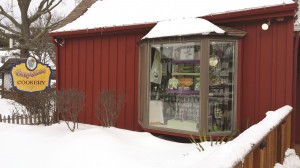 With nearly 70 percent of adult Americans overweight or obese and the weight loss industry valued at around $60 million in 2014, Lane points out that there is a major opportunity for kitchenware retailers to get on board with educating their customers and garner a portion of the weight loss market. She spoke to 200 members of Gourmet Catalog & Buying Group in Atlanta at AmericasMart this January on the topic of how retailers can position themselves to become a valuable resource to help communities achieve healthy lifestyle goals.
With nearly 70 percent of adult Americans overweight or obese and the weight loss industry valued at around $60 million in 2014, Lane points out that there is a major opportunity for kitchenware retailers to get on board with educating their customers and garner a portion of the weight loss market. She spoke to 200 members of Gourmet Catalog & Buying Group in Atlanta at AmericasMart this January on the topic of how retailers can position themselves to become a valuable resource to help communities achieve healthy lifestyle goals.
Fellow retailers can do so very simply, Lane says, just by adding in the healthy eating mantra and teaching customers and staff to look at products through an alternative lens. A SodaStream can be used to make sparkling water with muddled lemon added to replace a favorite cocktail or soda and add more water to the diet at the same time, for example. If a customer is considering a Silpat for cookies, let them know about healthy snacks they can make with it too — like chocolate covered oatmeal and Craisins for a preservative-free treat. Gray Goose Cookery carries Dizzy Pig BBQ rubs and Ariston infused olive oils, both of which are healthy ways to add flavor to a meal while lowering fat.
“It doesn’t have to be complicated. Simple healthy foods are where we should be going with this initiative in our industry,” says Lane. “There’s a huge opportunity for us to grow our businesses. We just need to be able to suggest it and then it’ll become practice for people; they’ll be thinking about it more, and it will make sense to them.”
This story was originally published in the March 2015 issue of Kitchenware News, a publication of Oser Communications Group.
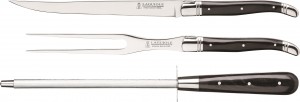
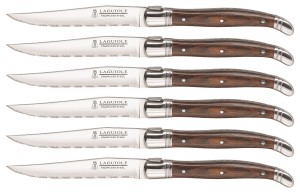
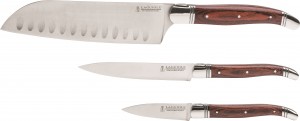
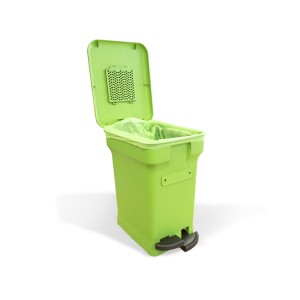

You must be logged in to post a comment.